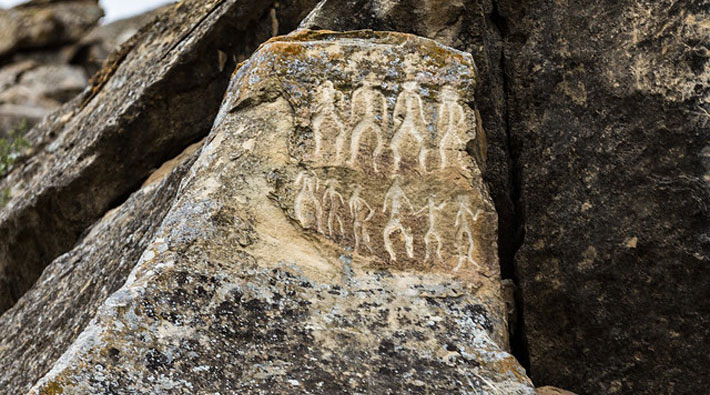History

The historical Azerbaijani lands are one of the most ancient cultural sites of modern civilization. Archaeological finds dis¬covered in Azykh, Taghlar, Damjili, Dashsalahli, Gazma caves and in other historical sites, including the lower jaw of the Azyk man - Azykhantrop, who lived 300-400,000 years ago, also prove Azerbaijan to be one of the sites of the formation of ancient human beings.
Azerbaijan hasancient traditions of statehood as the first state establishments or ethnic-political units appeared in the Azerbaijani territory in the late 4th-early 3rd millenniums BC.
Azerbaijan was occupied by Sasanian-Iranian Empire in the 3rd century and by the Arab Caliphate in the 7th century.
After the fall of the Caliphate, Azerbaijan restored its ancient statehood traditions starting from the middle 9th century.
In the second half of the 18th century, Azerbaijan was divided into small states – khanates and sultanates. Early 19th century the North of Azerbaijan annexed to Russia, while the South to Iran under theGulustan (1813) and Turkmenchay (1828) treaties.
The First Republic: Azerbaijan Democratic Republic (1918-1920)
On May 28, 1918, the first democratic parliamentary republic in the Muslim East – Azerbaijan Democratic Republic – was proclaimed. The republic made great strides in building an independent, democratic state, creating the first parliament and government, state apparatus and governing institutions, defining the country`s borders, establishing military units with high combat capability, ensuring territorial integrity and national security.
Guided by the principles of people power and equality from the very first days of its existence, Azerbaijan Democratic Republic eliminated racial, ethnic, religious and class inequalities by granting all citizens of the country the same rights. For the first time in the East and long before some European countries, women were granted the right to vote in Azerbaijan.
Azerbaijan during the Soviet era (1920-1991)
On April 28, 1920, Azerbaijan was occupied by the Bolshevik Russia. During the Soviet era, Azerbaijan’s statehood faced serious challenges. In 1920-1922, Azerbaijan formally maintained its independence which was de-facto recognized by the international community. In March 1922, three republics of the South Caucasus (Azerbaijan, Georgia, Armenia) were united under a single state of the Transcaucasian Soviet Federative Socialist Republic (TSFSR) which completely ended formal independence.
During the Soviet period, the territories of Zangazur, Goycha provinces, part of Nakhchivan and other regions were seized from Azerbaijan and annexed to Armenia. The area of Azerbaijan Democratic Republic was reduced from 114,000 sq km to 86,600 sq km. In addition, on July 7, 1923, the Nagorno-Karabakh Autonomous Oblast (NKAO) was established on the initiative of the Bolshevik leaders, which was a first step towards separating Nagorno-Karabakh from Azerbaijan.
Independent Republic of Azerbaijan (1991 - )
On October 18, 1991, when Azerbaijan gained its independence it declared itself as the political and legal successor of Azerbaijan Democratic Republic and demonstrated its commitment to its ancient traditions of statehood. Soon it restored state symbols of Azerbaijan Democratic Republic.
The first years of independence were extremely difficult for the Republic of Azerbaijan. The country was significantly weakened by Armenia’s expanding aggression, internal power struggle and collapse of the economy. Irresponsible activity of Popular Front-Musavat government brought Azerbaijan to the verge of collapse.
But national leader Heydar Aliyev`s returning to power in 1993 marked a turning point in the situation. On June 15, 1993, Heydar Aliyev was elected as chairman of the Supreme Soviet of the Republic of Azerbaijan. That day went down into the history of Azerbaijan as National Salvation Day. On June 23, the Milli Majlis entrusted the presidential power to Heydar Aliyev. The people united much closer around their leader. On October 3, 1993, Heydar Aliyev was elected as President of the Republic of Azerbaijan. Independent state building, ensuring security and territorial integrity, restoration of the economy, democratic development, establishment of international relations of Azerbaijan and its integration into the world community were the key priorities of Heydar Aliyev’s national development strategy
The national leader’s tenure as president from 1993 to 2003 went down in Azerbaijan`s history as a period of fundamental reforms.
The President of the Republic of Azerbaijan Ilham Aliyev has successfully continued national leader Heydar Aliyev`s policy since 2003. These years marked revival and modernization of all spheres of the country`s social life, the channeling of a major part of energy revenues into the diversification of the economy and development of the non-oil sector.
The implementation of numerous state programs and projects has played a crucial role in building a strong economic potential, mobilizing and effectively using human resources, creating up-to-date infrastructure in all the areas across the country, and improving people`s welfare. Nowadays Azerbaijan is a country that pursues an independent policy, enjoys great influence and is recognized as a reliable partner in the world.
President Ilham Aliyev’s purposeful policy, which is based on national interests, is unanimously supported by the people of Azerbaijan. This has been evidenced by the results of all the elections held in the country since 2003.





